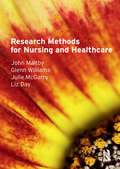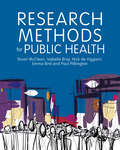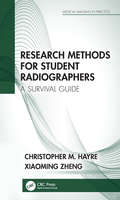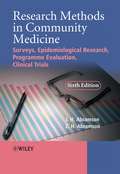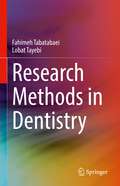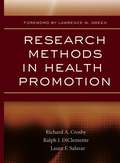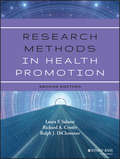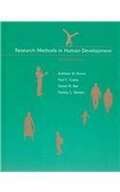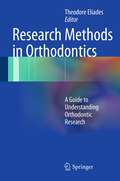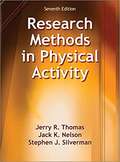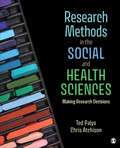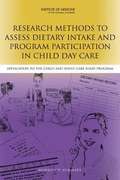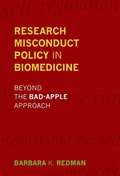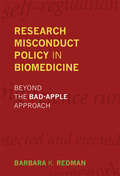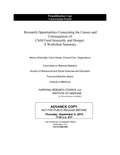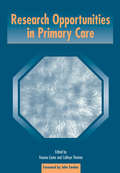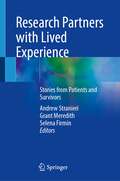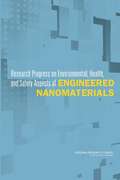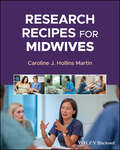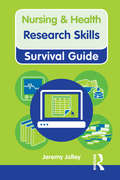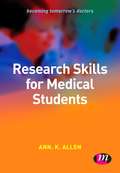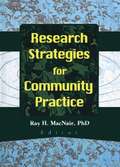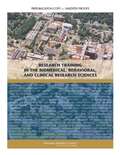- Table View
- List View
Research Methods for Nursing and Healthcare
by John Maltby Liz Day Glenn Williams Julie McgarryResearch Methods for Nursing and Healthcare is an essential introductory text for all nursing and healthcare students coming to research methods for the first time or those nurses and healthcare staff wishing to improve their skills in this area. The book includes comprehensive coverage of the main research methods topics, and provides guidance on how to understand and apply research techniques. Everyday nursing examples are used throughout to explain research methods concepts and their relevance to practice. Simple self-assessment tasks are included at the end of chapters; the tests can be undertaken individually, or within groups, to assess the student's understanding of the concepts and skills being learnt. Research Methods for Nursing and Healthcare takes the fear out of research methods for all nursing and healthcare professionals.Excellent introductory text that brings interest to research methods for student nurses.Dr Aimee Aubeeluck, Deputy Director: Graduate Entry Nursing, School of Nursing, Midwifery and Physiotherapy University of Nottingham"I think this is one of the most readable books on research I have read. Not the most scholarly, but that was not the intention. It is certainly the most user friendly book that will make the whole, often scary, subject of research less threatening."Paula Crick, Principal Lecturer, Faculty of Health, Staffordshire University"I do think this is one of the most engaging texts aimed at nursing that I have read in a while... This does seem much more exciting and more importantly. 'real world'"Lucy Land, Senior Academic, Centre for Health and Social Care Research Faculty of Health Birmingham City University"Useful resource for our students dissertation which can be a literature review or a research proposal"Melanie Brooke-Read, Department of Health & Social Studies, University of Bedfordshire"Excellent text book which actually takes away the 'fear' of research within healthcare"Angela Cobbold, Institute of Health & Social Care, Anglia Ruskin University"The text is very comprehensive and I found chapter 7 on action research particularly useful in supporting a student I was supervising. I also like the self assessment exercises which I intend to incorporate in my teaching strategy."Ms. Mulcahy, School of Nursing and Midwifery, University College Cork.
Research Methods for Public Health
by Stuart McClean Paul Pilkington Isabelle Bray Nick de Viggiani Emma BirdResearch Methods for Public Health offers an in-depth introduction to the theories, concepts, approaches and practices, relevant to research methods in a public health setting. Informed by a socio-ecological model of public health, the book uses real world research examples and contemporary social, political and environmental themes of public health that reflect UK and international contexts. The book provides a straightforward approach to developing a research project and applying methods in practical and realistic ways, using an innovative, integrative approach that combines methodologies. The authors have moved away from traditional approaches to research methods, and include chapters on primary quantitative, qualitative and mixed methods research, evidence synthesis approaches, critical appraisal, research governance and ethics, and dissemination. Essential reading for postgraduate students, researchers and public health practitioners, or individuals preparing for the UK Faculty of Public Health Part A examination.
Research Methods for Public Health
by Stuart McClean Paul Pilkington Isabelle Bray Nick de Viggiani Emma BirdResearch Methods for Public Health offers an in-depth introduction to the theories, concepts, approaches and practices, relevant to research methods in a public health setting. Informed by a socio-ecological model of public health, the book uses real world research examples and contemporary social, political and environmental themes of public health that reflect UK and international contexts. The book provides a straightforward approach to developing a research project and applying methods in practical and realistic ways, using an innovative, integrative approach that combines methodologies. The authors have moved away from traditional approaches to research methods, and include chapters on primary quantitative, qualitative and mixed methods research, evidence synthesis approaches, critical appraisal, research governance and ethics, and dissemination. Essential reading for postgraduate students, researchers and public health practitioners, or individuals preparing for the UK Faculty of Public Health Part A examination.
Research Methods for Student Radiographers: A Survival Guide (Medical Imaging in Practice)
by Christopher M. Hayre Xiaoming ZhengThis book provides an holistic picture of the application of research in radiography and focuses on multivariant methodological approaches and practices. It will provide readers insight into both contemporary and innovative methods within radiography research, backed up with evidence-based literature. This book may also be translated into other health disciplines as it introduces research to the reader by detailing terms that can often be confusing for students. These remain central in understanding the importance of research in radiography and how the generation of new knowledge is obtained. This will be supported with subsequent chapters concerning the literature, formation of research questions and detail the early beginnings of a research proposal. Chapters will include a wide range of topics, such as quantitative and qualitative methodologies and data collection tools pertinent to radiographic research, whilst discussing data analysis and need for rigor. The authors draw from our experiences, published outputs and clinical work, supported with alternate philosophies and methods used in diagnostic radiography. Each chapter will examine the multifaceted use and application of each ‘sub-theme’ pertinent to research in radiography, which is presented in a single text for students and, perhaps, practitioners. The targeted audience for this book is interdisciplinary but clearly focuses on those studying undergraduate radiography in response to the limited texts available. We also anticipate it to provide a useful tool for academics delivering undergraduate radiography programmes and those supporting postgraduate research. The key features will: • explore important research approaches and concepts within diagnostic radiography • provide contemporary evidence-based practice regarding mixed method approaches • provide a ‘how to guide’ for understanding key research principles in a wide range of radiographic settings • evaluate the impact of research on patients and the radiographer–patient relationship Dr. Christopher Hayre is a Senior Lecturer in Diagnostic Radiography at Charles Sturt University in New South Wales, Australia. Dr. Xiaoming Zheng has been teaching medical radiation science courses at Charles Sturt University since 1998.
Research Methods in Community Medicine
by Z. H. Abramson Joseph AbramsonA simple and systematic guide to the planning and performance of investigations concerned with health and disease and with health careOffers researchers help in choosing a topic and to think about shaping objectives and ideas and to link these with the appropriate choice of methodFully updated with new sections on the use of the Web and computer programmes freely available in the planning, performance or analysis of studies
Research Methods in Dentistry
by Lobat Tayebi Fahimeh TabatabaeiThis classroom-tested textbook will assist dental students with their academic research activities and help them to be competitive in today’s fast-growing research environment. It is designed as a core text for dental school classes such as Research Methodology and Scientific and Technical Writing, as well as Responsible Conduct of Research (RCR) training, but will also be a valuable resource for students and researchers in related fields, such as the medical sciences and biomedical engineering. The authors start the book by explaining key concepts and common approaches in dental research, both in basic science and clinical dentistry. They then familiarize readers with evidence-based research in dentistry and how to write a systematic review, explain the process of designing and presenting a proposal, discuss reporting results both in scientific and clinical research, and cover ethics in research, highlighting the significance of adherence to ethics both in animal as well as human studies.
Research Methods in Health Promotion
by Richard A. Crosby Ralph J. Diclemente Laura F. SalazarResearch Methods in Health Promotion provides students (advanced undergraduate and graduate students) and practitioners with basic knowledge and skills regarding the design, implementation, analysis, and interpretation of research in the field of health promotion. Taking the perspective that research involves a predetermined series of well-defined steps, the book presents these steps in a sequential format.
Research Methods in Health Promotion
by Richard A. Crosby Laura F. Salazar Ralph J. DiClementeThe bestselling textbook to understanding health research, updated and expanded Research Methods in Health Promotion provides students and practitioners with essential knowledge and skills regarding the design, implementation, analysis, and interpretation of research in the field of health promotion. Now in its second edition, this bestselling textbook has been updated with more recent research methodologies and additional information on sampling, participatory and survey research, and qualitative data analysis. The entire research process is covered, with specific points relating to both qualitative and quantitative research. By breaking the daunting process of research into simple and well-defined steps, this user-friendly text encourages students to think about research as a sequential process and provides explanations that facilitate better understanding of each step in the research process. A separate set of chapters cover the more quantitative methodological areas including designs, measurement, sampling, and data analysis in depth, giving readers the understanding they need to apply in practice. This book also provides applied chapters that illustrate the practical aspects of the research process, along with other critical information including grant writing and scientific writing. Evaluate the ethics, design, analysis, and interpretation of research Identify and understand the key components of research studies Analyze and interpret the results of experimental and survey research designs Understand the process of publishing a research report and constructing a grant proposal Research Methods in Health Promotion is ideal for both undergrad and graduate methods courses in health promotion and public health.
Research Methods in Human Development
by Paul C. Cozby Kathleen Brown Daniel W. KeeThis introductory text is designed for applied research methods courses focused on human development. Accessible and clearly written, the text reflects an interdisciplinary, life-span approach as well as a complete balance between experimental and non-experimental methods.
Research Methods in Orthodontics
by Theodore EliadesThe orthodontic literature includes many articles on basic science and engineering research techniques, but clinicians are typically unfamiliar with the principles underlying these techniques and may also lack the background knowledge required for a full appreciation of their role. This book comprehensively reviews a wide array of the research methods most frequently encountered in the literature, encompassing the areas of materials science and clinical and biological research. The various methods and techniques are carefully described, and their indications and limitations are explained. All of the information is up to date, reflecting latest developments in the field. For practicing professionals, Research Methods in Orthodontics will be an ideal introduction to instrumental analysis and basic science research methods. It will also serve as an excellent reference guide for researchers.
Research Methods in Physical Activity
by Stephen J. Silverman Jerry R. Thomas Jack K. NelsonResearch Methods in Physical Activity, Seventh Edition, systematically guides students through the research process, introducing methods and tools specifically for kinesiology and exercise science disciplines, including the subdisciplines of physical therapy, rehabilitation, and occupational therapy. The seventh edition leads students and novice researchers to research competency with the distinctive humor that has become a trademark of this internationally recognized text. <P><P> This text provides step-by-step information for every aspect of the research process, from identifying and devising research questions to analyzing data and compiling results for presentation. Methods for qualitative, quantitative, and mixed-methods research approaches are addressed, and real-world research questions—including historical, experimental, epidemiological, and philosophical—are presented by scholarly contributors who give suggestions for approaches to follow. Photos, anecdotes, and humorous stories are used throughout the text to put students at ease and emphasize key points through practical applications. Enhancements to the seventh edition include the following: • Updated information and techniques for electronic searches to ensure students use best research practices • New information on meta-analysis and the benefits of journal-style writing that teach readers to evaluate and prepare data for scholarly journals and publication • Special attention to ethical issues to help readers understand the regulations involved in using human and animal subjects • New information on logistic regression that aids in the understanding of complex ideas • Further explanation of qualitative and mixed-methods research approaches, in addition to quantitative approaches, to ensure readers use the most appropriate methodology for their research <P><P> The content of the seventh edition maintains and expands upon the logical content progression that has made Research Methods in Physical Activity the leading text in the field. <P><P> Part I presents an overview of the research process, including problem development, preparation of the research plan, and understanding ethical issues in research and writing. Part II introduces statistical and measurement issues in research, and part III presents various types of or approaches to research and methodology from expert researchers in the field. Part IV includes a writing guide for result findings and details how to develop and organize research papers and presentations. Statistical tables and guides are available in the appendix. <P><P> To aid instructors, Research Methods in Physical Activity, Seventh Edition, includes a suite of ancillary materials featuring an instructor guide, test package, an extra data set for instructors who wish to create specialized learning activities, and presentation package plus image bank. <P><P> Research Methods in Physical Activity, Seventh Edition, instills in students the confidence to devise, collect, analyze, and present their research in a competent manner by systematically guiding them through the research process. It is an essential text for all emerging researchers in physical activity.
Research Methods in the Social and Health Sciences: Making Research Decisions
by Ted Palys Chris AtchisonResearch Methods in the Social and Health Sciences: Research Decisions, by Ted Palys and Chris Atchison, gives students a thorough, thoughtful, and highly readable introduction to the entire research process from start to finish. From its underlying premise that your research questions and objectives, rather than any specific method, should guide your research, this book discusses each step of the research process, from limiting the scope of a literature review to navigating ethical considerations to deciding which methods are best suited for finding answers to specific research questions to how to analyze data and present findings. Readers are encouraged to think deeply about each step of the research process. The book promotes this deliberation by discussing the strengths and limitations of different methods and. Throughout the process, the authors provide many examples from their own and student research, sharing insights for research decisions arising from that experience. Readers will develop the skills to create solid research questions, perform literature reviews, identify appropriate data sources and methods, conduct research, analyze and interpret data and translate the resulting knowledge generated from the research process to a wider audience– all core parts of the research process –by developing their knowledge and creating confidence in their own decision-making skills. After explaining the unique and often complementary strengths of qualitative and quantitative methods, students focus on what methods are best suited for finding answers to the research questions that interest them. Major types of research including experiments, case studies, surveys, quasi-experiments, ethnographies, focus groups, participatory action research, and archival studies all receive significant coverage. The text illustrates how these methods are enhanced by integrating them with 21st century technologies and combining them in mixed methods projects. Chapters on constructing a research proposal and disseminating research bookend the process with concrete steps in between to support students designing their own original research projects. Study questions at the end of each chapter encourage students to think critically about the research process and how the choices a researcher makes will broaden or constrain what they can find. By the end of the text, social and health science students will feel confident in undertaking ethical and thoughtful research.
Research Methods in the Social and Health Sciences: Making Research Decisions
by Ted Palys Chris AtchisonResearch Methods in the Social and Health Sciences: Research Decisions, by Ted Palys and Chris Atchison, gives students a thorough, thoughtful, and highly readable introduction to the entire research process from start to finish. From its underlying premise that your research questions and objectives, rather than any specific method, should guide your research, this book discusses each step of the research process, from limiting the scope of a literature review to navigating ethical considerations to deciding which methods are best suited for finding answers to specific research questions to how to analyze data and present findings. Readers are encouraged to think deeply about each step of the research process. The book promotes this deliberation by discussing the strengths and limitations of different methods and. Throughout the process, the authors provide many examples from their own and student research, sharing insights for research decisions arising from that experience. Readers will develop the skills to create solid research questions, perform literature reviews, identify appropriate data sources and methods, conduct research, analyze and interpret data and translate the resulting knowledge generated from the research process to a wider audience– all core parts of the research process –by developing their knowledge and creating confidence in their own decision-making skills. After explaining the unique and often complementary strengths of qualitative and quantitative methods, students focus on what methods are best suited for finding answers to the research questions that interest them. Major types of research including experiments, case studies, surveys, quasi-experiments, ethnographies, focus groups, participatory action research, and archival studies all receive significant coverage. The text illustrates how these methods are enhanced by integrating them with 21st century technologies and combining them in mixed methods projects. Chapters on constructing a research proposal and disseminating research bookend the process with concrete steps in between to support students designing their own original research projects. Study questions at the end of each chapter encourage students to think critically about the research process and how the choices a researcher makes will broaden or constrain what they can find. By the end of the text, social and health science students will feel confident in undertaking ethical and thoughtful research.
Research Methods to Assess Dietary Intake and Program Participation in Child Day Care: Workshop Summary
by Leslie PrayMore than 16 million children in the United States live in food-insecure households where they are unable to obtain enough food to meet their needs. At the same time, a growing number of children are overweight or obese. Because of these challenges, improving child nutrition has emerged as one of the nation's most urgent public health needs. The Child and Adult Care Food Program (CACFP), a U. S. Department of Agriculture (USDA) food program, served about 3. 3 million children in 2011, as well as more than 124,000 adults who require daily supervision or assistance. Since many children rely on CACFP for the majority of their daily food, the quality of foods provided has the potential to greatly improve the health of the children's diets. The USDA asked the IOM to review and recommend improvements, as necessary, to the CACFP meal requirements in order to keep them aligned with other federally funded food assistance programs and with the Dietary Guidelines for Americans. The 2011 IOM report, Child and Adult Care Food Program Aligning Dietary Guidance for All, reviewed the program in detail and provided recommendations for improvement. In February 2012, at the request of the USDA, the IOM conducted an additional workshop to examine research methods and approaches that could be used to design and conduct a nationally representative study assessing children's dietary intake and participation rates in child care facilities, including CACFP-sponsored child care centers and homes. Research Methods to Assess Dietary Intake and Program Participation in Child Day Care: Application to the Child and Adult Care Food Program Workshop Summary is the report that summarizes the workshop.
Research Misconduct Policy in Biomedicine
by Barbara K. RedmanFederal regulations that govern research misconduct in biomedicine have not been able to prevent an ongoing series of high-profile cases of fabricating, falsifying, or plagiarizing scientific research. In this book, Barbara Redman looks critically at current research misconduct policy and proposes a new approach that emphasizes institutional context and improved oversight. Current policy attempts to control risk at the individual level. But Redman argues that a fair and effective policy must reflect the context in which the behavior in question is embedded. As journalists who covered many research misconduct cases observed, the roots of fraud "lie in the barrel, not in the bad apples that occasionally roll into view." Drawing on literature in related fields -- including moral psychology, the policy sciences, the organizational sciences, and law -- as well as analyses of misconduct cases, Redman considers research misconduct from various perspectives. She also examines in detail a series of clinical research cases in which repeated misconduct went undetected and finds laxity of oversight, little attention to harm done, and inadequate correction of the scientific record. Study questions enhance the book's value for graduate and professional courses in research ethics.Redman argues that the goals of any research misconduct policy should be to protect scientific capital (knowledge, scientists, institutions, norms of science), support fair competition, contain harms to end users and to the public trust, and enable science to meet its societal obligations.
Research Misconduct Policy in Biomedicine: Beyond the Bad-Apple Approach (Basic Bioethics)
by Barbara K. RedmanAn analysis of current biomedical research misconduct policy that proposes a new approach emphasizing the context of misconduct and improved oversight.Federal regulations that govern research misconduct in biomedicine have not been able to prevent an ongoing series of high-profile cases of fabricating, falsifying, or plagiarizing scientific research. In this book, Barbara Redman looks critically at current research misconduct policy and proposes a new approach that emphasizes institutional context and improved oversight. Current policy attempts to control risk at the individual level. But Redman argues that a fair and effective policy must reflect the context in which the behavior in question is embedded. As journalists who covered many research misconduct cases observed, the roots of fraud “lie in the barrel, not in the bad apples that occasionally roll into view.” Drawing on literature in related fields—including moral psychology, the policy sciences, the organizational sciences, and law—as well as analyses of misconduct cases, Redman considers research misconduct from various perspectives. She also examines in detail a series of clinical research cases in which repeated misconduct went undetected and finds laxity of oversight, little attention to harm done, and inadequate correction of the scientific record. Study questions enhance the book's value for graduate and professional courses in research ethics.Redman argues that the goals of any research misconduct policy should be to protect scientific capital (knowledge, scientists, institutions, norms of science), support fair competition, contain harms to end users and to the public trust, and enable science to meet its societal obligations.
Research Opportunities Concerning the Causes and Consequences of Child Food Insecurity and Hunger
by Institute of Medicine National Research Council Committee on National Statistics Division of Behavioral and Social Sciences and Education Food and Nutrition Board Nancy Kirkendall Connie Citro Carol HouseSection 141 of The Healthy, Hunger-Free Kids Act of 20101 provides funding for a research program on the causes and consequences of childhood hunger and food insecurity, and the characteristics of households with childhood hunger and food insecurity, with a particular focus on efforts to improve the knowledge base regarding contributing factors, geographic distribution, programmatic effectiveness, public health and medical costs, and consequences for child development, well-being, and educational attainment. The Economic Research Service and Food and Nutrition Service of the US Department of Agriculture conducted two outreach efforts to obtain input from the research community and other stakeholders to help focus on areas and methods with the greatest research potential. First, Food and Nutrition Service sought written comments to selected questions through publication of a Federal Register Notice. The second option was to convene a workshop under the auspices of the Committee on National Statistics of the National Research Council and the Food and Nutrition Board of the Institute of Medicine. Research Opportunities Concerning the Causes and Consequences of Child Food Insecurity and Hunger is the summary of that workshop, convened in Fall 2012 to examine research gaps and opportunities to advance understanding of the causes and consequences of child hunger in the United States. This report reviews the adequacy of current knowledge, identifies substantial research gaps, and considers data availability of economic, health, social, cultural, demographic, and other factors that contribute to childhood hunger or food insecurity. It also considers the geographic distribution of childhood hunger and food insecurity; the extent to which existing federal assistance programs reduce childhood hunger and food insecurity; childhood hunger and food insecurity persistence, and the extent to which it is due to gaps in program coverage; and the inability of potential participants to access programs, or the insufficiency of program benefits or services. Research Opportunities Concerning the Causes and Consequences of Child Food Insecurity and Hunger will be a resource to inform discussions about the public health and medical costs of childhood hunger and food insecurity through its focus on determinants of child food insecurity and hunger, individual, community, and policy responses to hunger, impacts of child food insecurity and hunger, and measurement and surveillance issues.
Research Opportunities in Primary Care
by Kate Thomas Yvonne Carter'Medical technology is beneficial for well researched dangerous diseases. However, most symptoms that people bring to their primary care physician have no single clearly identifiable cause: investigations and drugs do more harm than good - and also waste resources - ' - Wilfrid Treasure Diagnosis and Risk Management in Primary Care teaches that adopting an evidence-based approach to primary care improves patient care and treatment outcomes. It demonstrates that brief clinical assessments, repeated if necessary, allow effective diagnosis while avoiding the costs and complications associated with more advanced testing. Adopting a fresh approach, this book sets consultation skills alongside evidence-based information by both itemising the specific techniques and facts that are needed in the consulting room, and providing detailed information on odds and likelihood ratios to quantify risk and deal with uncertainty. This book provides food for thought, and helps doctors develop communication skills that support their personal styles of consulting, encouraging a more traditional, intuitive treatment. It provides a map of the consultation and a compass to navigate through symptoms, signs and evidence - listening to their patients with one ear and, with the other, to the reflective inner voice of reason. General Practitioner Specialist Trainees and their teachers will find much of interest, as will established General Practitioners with an interest in maintaining traditional models of care. Undergraduate medical students and candidates for the MRCGP will find this an ideal reader for the clinical skills assessment. 'What a breath of fresh air to find an author capable of putting the patient back at the centre of the consultation and who is able to entertain at the same time as he informs and to stimulate critical reflection while nudging us in the direction of a rigorous approach to diagnosis, and the assessment and communication of risk.' From the foreword by Roger Jones
Research Partners with Lived Experience: Stories from Patients and Survivors
by Andrew Stranieri Grant Meredith Selena FirminThis book aims to foster collaborations between patients who have intense lived experience with a medical condition or family violence and researchers investigating them. Inviting patients or survivors into the research team is found to have significant advantages, and chapters review the literature on the benefits they can bring to investigative research teams. The collaboration can take place at multiple stages of research from helping to research design, participating in co-investigators, contributing to the interpretation of results, etc. The conditions addressed in this book include medical conditions from anxiety, postural orthostatic tachycardia syndrome, lupus, asthma, chronic kidney disease, etc. The authors are higher degree students, academics, and active research team members who share their experiences. This is be instrumental in helping patients and survivors decide whether to transition to research. It will also support research team leaders in determining how to benefit from the new perspectives researchers with lived experience bring. The personal narratives provide insight into the challenges and rewards of having lived experience while conducting research. This book is a valuable resource for researchers in clinical fields who have been touched by firsthand exposure to a condition and have been motivated to conduct research in the respective fields. The chapters will enrich understanding for adult patients and survivors and for parents of children suffering intense experiences, who engage with the latest research publications. It will also broaden the understanding of medical, biomedical, and health sciences students interested in reading the narrative accounts of patients and survivors. Readers will gain refreshing perspectives and insights. The book relates to patients managing all kinds of noncommunicable diseases or experiences of violence, and how they can share their valuable experiences into future advancementto research. It is related to SDG 3, good health and well-being.
Research Progress on Environmental, Health, and Safety Aspects of Engineered Nanomaterials
by Toxicology Committee to Develop a Research Strategy for Environmental StudiesDespite the increase in funding for research and the rising numbers of peer-reviewed publications over the past decade that address the environmental, health, and safety aspects of engineered nanomaterials (ENMs), uncertainty about the implications of potential exposures of consumers, workers, and ecosystems to these materials persists. Consumers and workers want to know which of these materials they are exposed to and whether the materials can harm them. Industry is concerned about being able to predict with sufficient certainty whether products that it makes and markets will pose any environmental, health or safety issues and what measures should be taken regarding manufacturing practices and worldwide distribution to minimize any potential risk. However, there remains a disconnect between the research that is being carried out and its relevance to and use by decision-makers and regulators to make informed public health and environmental policy and regulatory decisions. "Research Progress on Environmental, Health, and Safety Aspects of Nanomaterials" evaluates research progress and updates research priorities and resource estimates on the basis of results of studies and emerging trends in the nanotechnology industry. This report follows up the 2012 report "A Research Strategy for Environmental, Health, and Safety Aspects of Engineered Nanomaterials," which presented a strategic approach for developing the science and research infrastructure needed to address uncertainties regarding the potential environmental, health, and safety risks posed by ENMs. This new report looks at the state of nanotechnology research, examines market and regulatory conditions and their affect on research priorities, and considers the criteria for evaluating research progress on the environmental, health, and safety aspects of nanotechnology.
Research Recipes for Midwives
by Caroline J. Hollins MartinResearch Recipes for Midwives A 16-step guide to writing a research proposal Development of a research question, identification of a research method, and working through the steps to build a sample are complex and hugely important stages in the career of a student midwife. A good research ‘recipe’—a specific method geared to address a certain kind of question—can be critical to the creation of a successful proposal. Research Recipes for Midwives offers a selection of thoroughly tested research methods from which student midwives can choose in developing their own projects, expertly directing the reader through a 16-step process for applying a ‘recipe’ to their own proposal. Reader will also find: Information regarding the relationship between midwifery research and practice A thorough introduction to research methods built around clear concepts Tools for making a complex and challenging process manageable and exciting Research Recipes for Midwives is the ideal resource for student midwives developing research proposals, particularly those enrolled in research methods modules, providing readers with an edge in this foundational element of the research process.
Research Skills (Nursing and Health Survival Guides)
by Jeremy JolleyDo you need to conduct or understand research to support your studies or evidence-based practice in healthcare? Ensure that you have all the research tools at your finger tips with this quick reference guide covering both quantitative and qualitative research.
Research Skills for Medical Students (Becoming Tomorrow′s Doctors Series)
by Ann AllenThe revised Tomorrow′s Doctors makes it clear that doctors need to be aware of their responsibilities as scholars and scientists and it is therefore vital that students develop excellent research skills. Whilst there are many ′research skills′ books, medical students frequently struggle with understanding the difference between the practices of research, audit, service evaluation, systematic and narrative reviews and when and how to apply them. This book addresses the kinds of questions novice investigators always ask and helps students utilise study designs, data collection tools and analysis effectively.
Research Strategies for Community Practice
by Ray H MacnairIn Research Strategies for Community Practice, you’ll discover how you can more effectively work together with other practitioners and researchers in the interests of knowledge development and practice assessment. You’ll also gain access to the conceptual rationale, research design process, and research utilization process necessary for success in the context of community organizing.Research Strategies for Community Practice raises crucial issues for you and other community practitioners. In chapters on historical research strategies, you’ll discover the need for reform in research procedures, which will aid you in setting goals, establishing political agendas, and exploring new policy directions. In the chapters covering community network analysis, you’ll find human service and support systems. Specifically, your understanding of this vital area of community practice will develop and flourish in these and many other important areas: uses of historical research assessment, planning, and evaluation through network analysis single system research design the research process in community-based empowerment systems collaborative research participants in the context of adolescent healthReaders from all backgrounds, including doctoral students in social work, sociology, and public administration who have an interest in community practice, will want to take a look inside the proven techniques and sound research in Research Strategies for Community Practice. You’ll find a practical community of professional researchers and practitioners who have compiled the most successful strategies for conducting and bettering research in your community practice.
Research Training in the Biomedical, Behavioral, and Clinical Research Sciences
by National Research Council of the National AcademiesComprehensive research and a highly trained workforce are essential for the improvement of health and health care both nationally and internationally. Over the past 40 years the National Research Services Award (NRSA) Program has played a large role in training the workforce responsible for dramatic advances in the understanding of various diseases and new insights that have led to more effective and targeted therapies. In spite of this program, the difficulty obtaining jobs after the postdoc period has discouraged many domestic students from pursuing graduate postdoc training. In the United States, more than 50 percent of the postdoc workforce is made up of individuals who obtained their Ph.D.s from other countries. Indeed, one can make a strong argument that the influx of highly trained and creative foreigners has contributed greatly to U.S. science over the past 70 years. Research Training in the Biomedical, Behavioral, and Clinical Research Sciences discusses a number of important issues, including: the job prospects for postdocs completing their training; questions about the continued supply of international postdocs in an increasingly competitive world; the need for equal, excellent training for all graduate students who receive NIH funding; and the need to increase the diversity of trainees. The book recommends improvements in minority recruiting, more rigorous and extensive training in the responsible conduct of research and ethics, increased emphasis on career development, more attention to outcomes, and the requirement for incorporating more quantitative thinking in the biomedical curriculum.
